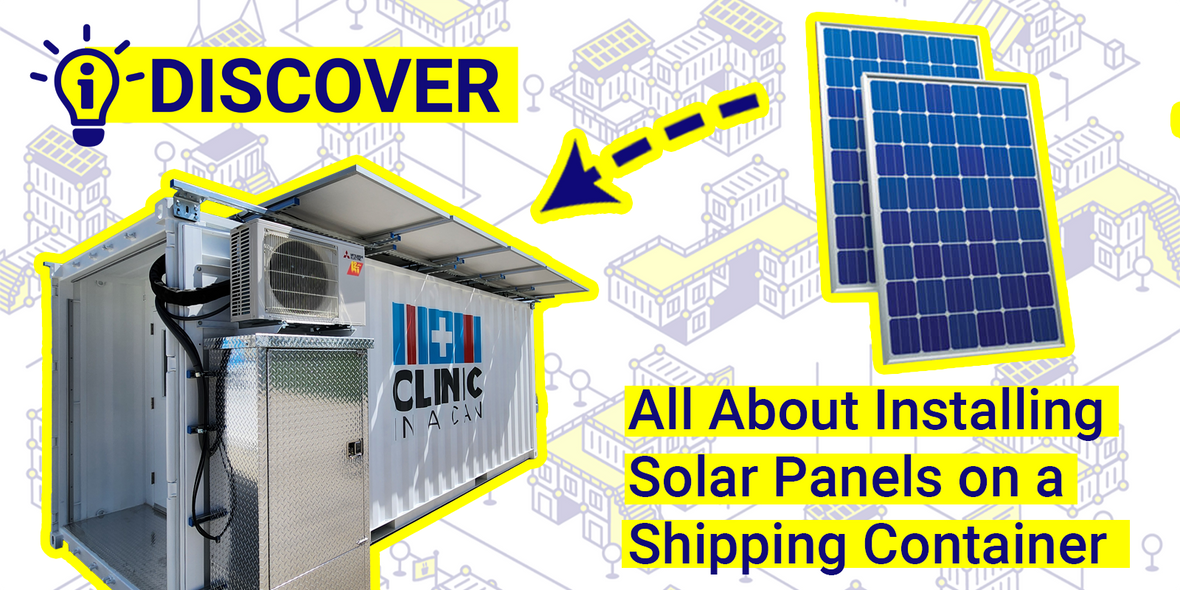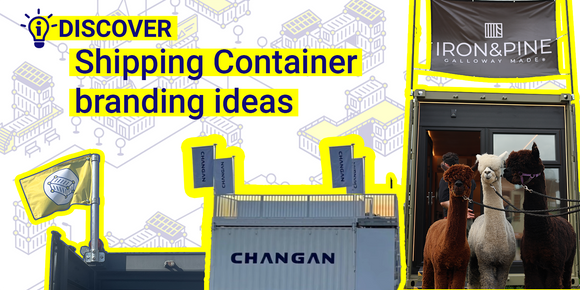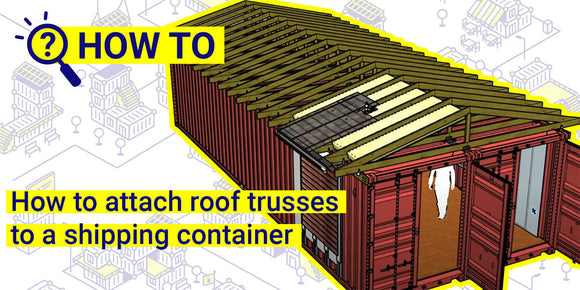
Installation de panneaux solaires sur des conteneurs: Comment faire
2 comments
Tout savoir sur l'installation de panneaux solaires sur un conteneur d'expédition
Vous envisagez d'installer des panneaux solaires sur un conteneur d'expédition et vous vous demandez ce qu'il faut garder à l'esprit ? Cet article propose une vue d'ensemble concise pour vous aider à comprendre les éléments clés à prendre en compte et vous présente quelques exemples concrets.

Peut-on installer des panneaux solaires sur le toit d'un conteneur d'expédition ?
Tout à fait ! Le montage de panneaux solaires sur des conteneurs d'expédition est de plus en plus populaire. Les panneaux photovoltaïques devenant plus légers et plus abordables, et l'intérêt pour les énergies renouvelables augmentant, de plus en plus de personnes se tournent vers des solutions de conteneurs alimentés par l'énergie solaire.
L'installation de l'énergie solaire sur votre maison ou votre bureau en conteneur peut contribuer à réduire les coûts d'électricité ou même à rendre possible la transition vers un mode de vie hors réseau. Ces systèmes peuvent alimenter le chauffage, les lumières, les ordinateurs, etc., ce qui les rend très pratiques pour les maisons en conteneurs, les bureaux, etc.
Combien de panneaux solaires peuvent être installés sur un conteneur d'expédition de 20 pieds ?
Le nombre de panneaux solaires pouvant être installés sur un conteneur d'expédition de 20 pieds dépend de la taille et de la disposition des panneaux. Les panneaux solaires standard mesurent généralement environ 1 m de large et 1,9 m de haut, chaque panneau couvrant environ 17,55 m². La surface du toit du conteneur est d'environ 14,4 m2 (155 pieds carrés).
Un conteneur d'expédition de 20 pieds peut généralement accueillir de 6 à 12 panneaux solaires, en fonction de la taille du panneau et de la configuration de montage. Avec six à douze panneaux de 300 W, vous pouvez vous attendre à une puissance de 1,8 kWp à 3,6 kWp. Pour les installations plus compactes ou les panneaux à haut rendement (400 W ou plus), jusqu'à 12 panneaux peuvent produire jusqu'à 4,8 kWp.
Tout cela suppose que vous puissiez orienter votre conteneur de manière optimale en fonction de l'ensoleillement.
Combien de panneaux solaires peuvent être installés sur un conteneur de 40 pieds ?
Un conteneur de 40 pieds offre une longueur et une surface de toit deux fois supérieures à celles d'un conteneur de 20 pieds, ce qui signifie en théorie deux fois plus de panneaux solaires et deux fois plus de puissance. Cependant, des facteurs pratiques tels que l'intégrité structurelle, l'orientation des panneaux et l'accès pour la maintenance peuvent limiter le nombre de panneaux pouvant être installés. Le doublement du nombre de panneaux signifie probablement une résistance au vent deux fois plus importante, et les cadres devront donc être suffisamment solides pour supporter le poids supplémentaire et les mouvements potentiels. Nos supports de toit pour conteneurs d'expédition peuvent aider à stabiliser les cadres solaires sur toute la longueur du conteneur.
Où dois-je placer le conteneur pour obtenir la meilleure exposition au soleil ?
Pour maximiser la capture de l'énergie solaire tout au long de la journée, le conteneur d'expédition doit être placé avec ses longs côtés orientés d'est en ouest. La large surface du toit est ainsi orientée vers le sud (dans l'hémisphère nord) ou vers le nord (dans l'hémisphère sud), ce qui assure la meilleure exposition aux rayons du soleil pour les panneaux solaires. La deuxième meilleure option consiste à placer le toit de manière à ce que ses côtés courts soient orientés d'est en ouest. Dans les deux cas, les panneaux solaires et le cadre doivent être perpendiculaires au conteneur et leur alignement doit être optimal pour capter la lumière du soleil.
Bien entendu, il est également préférable d'éviter les zones ombragées à tout moment de la journée ou de l'année. N'oubliez pas que le soleil est beaucoup plus bas dans le ciel en hiver dans de nombreuses régions du monde. Il existe plusieurs applications qui vous indiqueront exactement la hauteur du soleil au cœur de l'hiver, ce qui vous permettra de voir si le soleil sera obstrué par des arbres ou des bâtiments à proximité.
Pourquoi les gens installent-ils des panneaux solaires sur des conteneurs ?
Maisons en conteneurs d'expédition
Bureaux de chantier portables
Usage agricole
Production d'énergie
Quels sont les avantages de l'installation de panneaux solaires sur un conteneur d'expédition ?
L'utilisation de panneaux solaires sur un conteneur d'expédition présente plusieurs avantages :
*Le conteneur lui-même fournit le support structurel pour le cadre solaire, il n'est donc pas nécessaire de construire une nouvelle structure ou de creuser des fondations
*Le conteneur est facilement transportable, il offre donc une source d'énergie supplémentaire fiable dans les endroits éloignés
*Les conteneurs d'expédition solaires peuvent être en mesure de contourner les réglementations en matière d'urbanisme.
*Le conteneur peut abriter le système de stockage des batteries que les panneaux alimentent
*Offre l'indépendance énergétique / l'autosuffisance pour les bâtiments en conteneur dans les endroits non raccordés au réseau
*Réduit les coûts d'électricité
*Soutient le développement durable en réduisant la dépendance à l'égard des combustibles fossiles
*Réduit votre empreinte carbone
Qu'il s'agisse de votre maison en conteneur, d'un bureau en conteneur, d'un café en conteneur ou d'un autre type d'entreprise mobile, l'utilisation du soleil comme source d'énergie est une solution respectueuse de l'environnement, indépendante et, à long terme, économique.
Quels sont les défis possibles lors de l'installation de panneaux solaires sur le toit d'un conteneur maritime ?
Voici quelques difficultés et éléments à prendre en compte lors de l'installation de panneaux solaires sur le toit d'un conteneur :
- Les panneaux solaires et le cadre doivent être fixés en toute sécurité au conteneur pour résister aux conditions environnementales locales.
- Le poids des panneaux et du cadre doit reposer sur les moulages d'angle et les rails latéraux supérieurs du conteneur, et non sur les panneaux de toit.
- L'angle et le positionnement des panneaux devront être ajustés pour une exposition optimale à la lumière du soleil - soit le conteneur doit être tourné d'est en ouest, soit les panneaux doivent être tournés sur le conteneur.
- Il peut être nécessaire de monter ou d'installer à proximité des équipements supplémentaires tels que des batteries et des onduleurs.
- Les panneaux solaires sont montés avec suffisamment d'espace pour y accéder afin de les nettoyer et de les entretenir.
Quel est l'entretien nécessaire pour les panneaux solaires ?
L'entretien consiste généralement à nettoyer régulièrement les panneaux afin d'éliminer la poussière et les débris, et à inspecter les connexions et le matériel de montage pour vérifier qu'ils ne sont pas usés.
Pour s'assurer que tout fonctionne bien et efficacement, il est nécessaire de surveiller les performances du système. L'avantage est que la plupart des panneaux solaires sont garantis pendant 20 à 25 ans, mais il est essentiel de suivre les directives du fabricant en matière d'entretien.
Comment monter des panneaux solaires sur un conteneur d'expédition ?
Le montage de panneaux solaires sur un conteneur d'expédition comporte plusieurs étapes afin de garantir une installation stable et efficace. Nous vous recommandons de jeter un coup d'œil aux solutions proposées par deux de nos clients.
Clinique en boîte : Montage solaire flexible pour les soins de santé mobiles
Un exemple est celui de Clinic in a Can, qui fournit des cliniques médicales entièrement équipées à l'intérieur de conteneurs d'expédition alimentés par l'énergie solaire. Le projet Clinic in a Can est un excellent exemple de la façon dont l'énergie solaire peut rendre les installations basées sur des conteneurs d'expédition complètement autonomes. Leurs unités s'appuient sur des panneaux solaires pour alimenter l'équipement médical essentiel, l'éclairage et l'air conditionné. L'approche unique de Clinic in a Can permet de déployer des installations de soins de santé dans des zones éloignées ou mal desservies.

Grâce aux Domino Clamps, les panneaux solaires peuvent être facilement montés et démontés sur n'importe quel conteneur d'expédition ISO, sans qu'il soit nécessaire de percer ou de souder. Cette flexibilité permet d'ajuster ou de déplacer les installations solaires en fonction des besoins. Elle garantit une installation sûre et efficace des panneaux avec un impact structurel minimal sur le conteneur. Clinic in a Can utilise désormais une combinaison d'ossatures en profilés et de Domino Clamp pour plusieurs de ses cliniques, car elle offre un moyen stable et simple d'installer des panneaux solaires.
Clinic in a Can a utilisé nos Domino Clamps et nos équerres en acier pour fixer le cadre de leur panneau solaire. N'hésitez pas à nous contacter et à nous envoyer un e-mail si vous avez besoin de conseils.
Refroidisseur solaire : Installation sécurisée pour les sites isolés sans outils électriques

Un autre exemple provient d'un projet d'ingénierie d'étudiants de l'Université de Liverpool, qui ont collaboré avec un collectif d'agriculteurs à Zanzibar pour créer un entrepôt frigorifique alimenté par l'énergie solaire, le Solar Chiller. Ils ont utilisé des pinces et des supports Domino pour fixer un cadre Unistrut au toit du conteneur.
Leur conception modulaire peut être montée et démontée avec de simples outils à main, ce qui la rend accessible à tous, quelle que soit l'expérience ou même l'accès à l'électricité. Cette installation, qui peut accueillir six panneaux, permet d'utiliser efficacement le toit du conteneur et de couvrir la quasi-totalité de la surface du toit.
Lisez l'étude de cas sur le montage de panneaux solaires sur un conteneur d'expéditionpour voir comment ils ont installé leur système pour ce projet.
Conclusion - Tirez le meilleur parti de votre toit de conteneur grâce à l'énergie solaire
Les panneaux solaires sur les conteneurs d'expédition constituent un moyen intelligent et durable de produire de l'énergie, pour les maisons en conteneurs, les bureaux ou les installations de conteneurs d'expédition éloignés. Dans l'ensemble, il s'agit d'une excellente façon d'utiliser le toit d'un conteneur d'expédition.
Grâce à des solutions telles que les Domino Clamps et l'ossature Unistrut, l'installation est plus facile, plus flexible et ne nécessite pas de perçage ou de soudage. Si vous envisagez d'installer des panneaux solaires dans un conteneur d'expédition, l'expérience d'applications réelles telles que Clinic in a Can ou Solar Chiller peut vous donner des indications précieuses sur la manière dont ces installations fonctionnent dans la pratique.
Voici quelques informations clés tirées de notre article :
- Un conteneur de 20 pieds peut contenir de 6 à 12 panneaux (environ 2,4 à 4,8 kWp), tandis qu'un conteneur de 40 pieds peut contenir de 12 à 24 panneaux (environ 4,8 à 6 kWp), en fonction de la configuration et de l'efficacité.
- Des solutions de montage à la fois flexibles et robustes, telles que les Domino Clamps et les cadres Unistrut, facilitent l'installation sans endommager le conteneur.
- Des projets tels que Clinic in a Can et Solar Chiller montrent comment l'énergie solaire peut transformer des conteneurs d'expédition en installations totalement autonomes.
- Si vous veillez à l'intégrité structurelle du conteneur, si vous répartissez correctement le poids, si vous protégez les panneaux contre le vent et les intempéries et si vous les placez de manière à ce qu'ils soient exposés de façon optimale à la lumière du soleil, vous pourrez profiter pleinement des avantages de l'énergie solaire produite sur le toit de votre conteneur.
Autres lectures et ressources
Pour plus d'informations, consultez les kits de démarrage Unistrut ou regardez notre vidéo sur la fixation d'Unistrut à un conteneur d'expédition à l'aide de Domino Clamps pour le montage de panneaux solaires et d'autres applications.
Si vous avez des questions, laissez-nous un commentaire ci-dessous ou contactez-nous par e-mail. Nous nous ferons un plaisir de vous aider !






Commentaires (2)
Hi Juain,
You’re on the right page! all the same principle’s apply to a 40’ as a 20ft container.
Ay other questions. send over to hello@dominoclamps.com
Thankyou